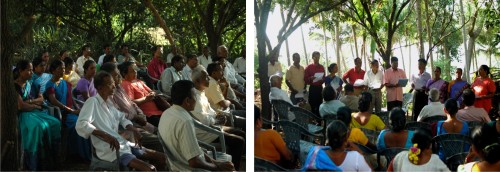We visited Bhooshan Nabar’s mango orchard in Vengurla yesterday (22nd March) to understand how mangoes are made ready for the market once harvested. Below are photos from the visit.

Bhooshan Nabar (foreground) and Sajjan with the mango orchard in the background

Nabar prefers to keep the undergrowth in check for fear of fires during the dry months

Alphonso tree laden with fruit

Because the trees have been regularly pruned, they are short and bear fruit so low that you could crouch under the branches and pluck them. Walli takes a moment to capture some photos

Pheromone traps are a simple and effective way to attract and trap insects that may damage the mangoes. Similar pheromone traps are available at the ZAO's office or even at Ela Farm in Old Goa.

Mango trees need looking after. Nabar digs a ring around the base of the tree at a distance of approximately 30 feet from the trunk. This ring is used to fertilise the tree. He uses bonemeal, dolomite (lime with Calcium and Magnesium), cow-dung and super-phosphate. Keeping the ring mulched helps retain moisture.

Mangoes being harvested

Freshly harvested mangoes

Nabar shows us his new plantation (3 years old). A bore-well and a drip irrigation system ensures that the trees get the water the need. The land is rocky and undulating, much like portions of land on our island of Chorao. No reason why we can't make similar plantations on our lands

(From left to right) Kalangutkar, Santosh, Mahambare, Walli, Sajjan, Nabar, Abreu (back), Arjun, Ramesh (back), Prava























